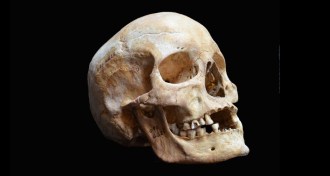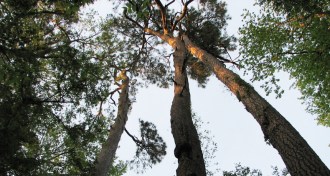
Senior writer Tina Hesman Saey is a geneticist-turned-science writer who covers all things microscopic and a few too big to be viewed under a microscope. She is an honors graduate of the University of Nebraska-Lincoln where she did research on tobacco plants and ethanol-producing bacteria. She spent a year as a Fulbright scholar at the Georg-August University in Göttingen, Germany, studying microbiology and traveling. Her work on how yeast turn on and off one gene earned her a Ph.D. in molecular genetics at Washington University in St. Louis. Tina then rounded out her degree collection with a master’s in science journalism from Boston University. She interned at the Dallas Morning News and Science News before returning to St. Louis to cover biotechnology, genetics and medical science for the St. Louis Post-Dispatch. After a seven year stint as a newspaper reporter, she returned to Science News. Her work has been honored by the National Academies of Sciences, Engineering and Medicine, the Endocrine Society, the Genetics Society of America and by journalism organizations.

Trustworthy journalism comes at a price.
Scientists and journalists share a core belief in questioning, observing and verifying to reach the truth. Science News reports on crucial research and discovery across science disciplines. We need your financial support to make it happen – every contribution makes a difference.
All Stories by Tina Hesman Saey
-
 Life
LifeLeprosy bacterium changed little in last millennium
Genome alterations probably not responsible for decline in disease prevalence.
-
 Animals
AnimalsNow-extinct wolf may be ancestor of modern-day dogs
No strong signs of canine ancestry among living grey wolves.
-
 Health & Medicine
Health & MedicineFlu spreads via airborne droplets
Hand washing goes only so far in retarding flu transmission.
-
 Life
LifeGenes weakly linked to education level
A search of more than 2 million DNA locations in more than 125,000 people finds a weak, and perhaps dubious, association with schooling.
-

-
 Life
LifeTests show that deadly flu could spread among people
Experiment shows that new influenza virus transmits through air between ferrets, a common experimental stand-in for humans.
-
 Life
LifeExperimental vaccine protects against many flu viruses
Ferrets that receive shot can fight off variety of influenza strains.
-
 Life
LifeViruses and mucus team up to ward off bacteria
Phages may play an unforeseen role in immune protection, researchers find.
-
 Humans
HumansHighlights from the Biology of Genomes meeting
Highlights from the genome biology meeting held May 7-11 in Cold Spring Harbor, N.Y., include an enormous tree's enormous genome, genes for strong-swimming sperm, and back-to-Africa migration some 3,000 years ago.
-
 Animals
AnimalsTamed fox shows domestication’s effects on the brain
Gene activity changes accompany doglike behavior in foxes bred over more than 50 years.
-

-
 Life
LifeGenetic fossils betray hepatitis B’s ancient roots
Modern bird genomes reveal evidence that virus is at least 82 million years old.